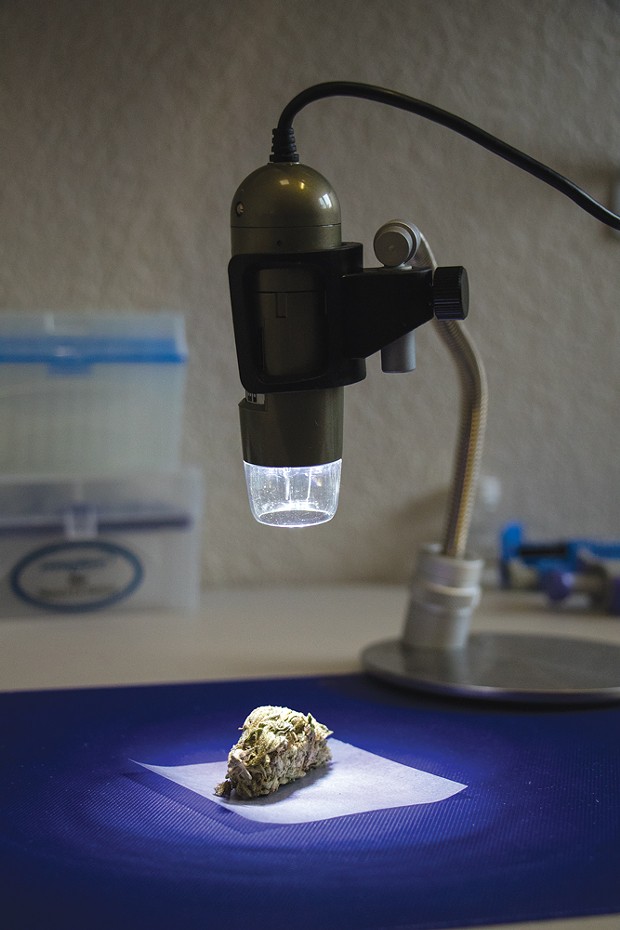State Awards $30 Million to Study Cannabis
HSU nabs grant to research economic impacts
By Thadeus Greenson [email protected] @ThadeusGreenson[
{
"name": "Top Stories Video Pair",
"insertPoint": "7",
"component": "17087298",
"parentWrapperClass": "fdn-ads-inline-content-block",
"requiredCountToDisplay": "1"
}
]
We're soon going to learn a whole lot about cannabis in California.
An often overlooked provision of California's landmark legalization measure — Proposition 64 — set aside funds for research grants to study the impacts of cannabis. Well, the Bureau of Cannabis Control recently announced that it is awarding nearly $30 million in grants of up to $2 million to a host of public universities across the state — including Humboldt State University — to study various aspects of cannabis, including public health, public safety and economic and environmental impacts.
"The research conducted through these public university grants will provide critical information for evaluating our legal cannabis system and its impacts," Bureau Chief Lori Ajax said in a press release. "This research will be a valuable tool to inform future cannabis policy in California."
Included in the grants are some massive studies. For example, the University of California at San Francisco received $2 million to conduct a "comprehensive analysis" of cannabis exposure on the developing brain, while UC Santa Barbara got $2 million to study the impacts of farm practices on the quantity, quality and toxicity of surface water emissions from cannabis cultivation sites. UC Davis, meanwhile, got $1 million to study cannabis use's impacts on early psychosis, while UCLA received $1 million to assess "the feasibility and consequences of implementing a cannabis potency tax in California" and UC Berkeley received $465,000 to explore issues surrounding tribal sovereignty over cannabis permitting on Native ancestral lands.
Closer to home, HSU received $183,000 to study the economic impact of cannabis legalization in rural Northern California. The study will be headed by Sonoma State University professor of economics Robert Eyler and done in collaboration with the Humboldt Business Development Center (HBDC) and the California Center for Rural Policy at HSU.
"We want to try and define the legal market so far, the employees, the businesses, their business structure (how they are organized and how they use commercial space, etc.), how government interacts as policy makers and regulators, and the broader economic impacts of the legal industry," Eyler wrote in an email to the Journal.
Eyler said the study will only look at the legal industry — not the unregulated market — and will use a survey instrument to gather data about pricing, operations and company structures, while also using data collected by the Bureau of Cannabis Control. He hopes the findings will be released in mid to late 2022.
Natalynne DeLapp, who serves as executive director of both the Humboldt County Growers Alliance and HBDC, said the first-of-its-kind study will look at the industry in Sonoma, Mendocino, Humboldt, Del Norte and Trinity counties and provide invaluable information to both policy makers and cannabis business owners.
"My hypothesis is that the data will show the importance of the cannabis industry to the health and success of the North Coast," she said. "I think it will show that the cannabis industry is the driving force in the Humboldt County economy. That's what I think, but I'm looking forward to seeing what the facts are."
DeLapp said that because the above-board cannabis industry is fairly new, it lacks the industry standards that are present in other sectors, making it really hard for business owners to evaluate their operations. And because producers have little control at this point over market prices, the key to maximizing profits is finding efficiencies, which is difficult to do when there aren't standard, accepted costs of production.
As an example, DeLapp said a thorough peer-reviewed breakdown detailing costs of production, standard wages, insurance rates and other factors will help cannabis businesses decide whether to automate aspects of their operations, pay overtime expenses or bring on another crew. Or it could help a grower decide whether they can really afford that environmentally friendly upgrade they want to make, she said.
"They're businesses," she said. "And they have to be thinking like businesses and counting everything. But to do that, you have to be able to understand the standard costs of production."
Thadeus Greenson (he/him) is the Journal's news editor. Reach him at 442-1400, extension 321, or [email protected]. Follow him on Twitter @thadeusgreenson.
more from the author
-
Failed Leadership
- May 2, 2024
-
'On Siemens Hall Hill'
How an eight-day occupation at Cal Poly Humboldt divided campus
- May 2, 2024
-
Faculty Association Condemns Clearing of Campus; Lawmakers Call for Healing
- Apr 30, 2024
- More »
Latest in News
Readers also liked…
-
Through Mark Larson's Lens
A local photographer's favorite images of 2022 in Humboldt
- Jan 5, 2023
-
'To Celebrate Our Sovereignty'
Yurok Tribe to host gathering honoring 'ultimate river warrior' on the anniversary of the U.S. Supreme Court ruling that changed everything
- Jun 8, 2023
































